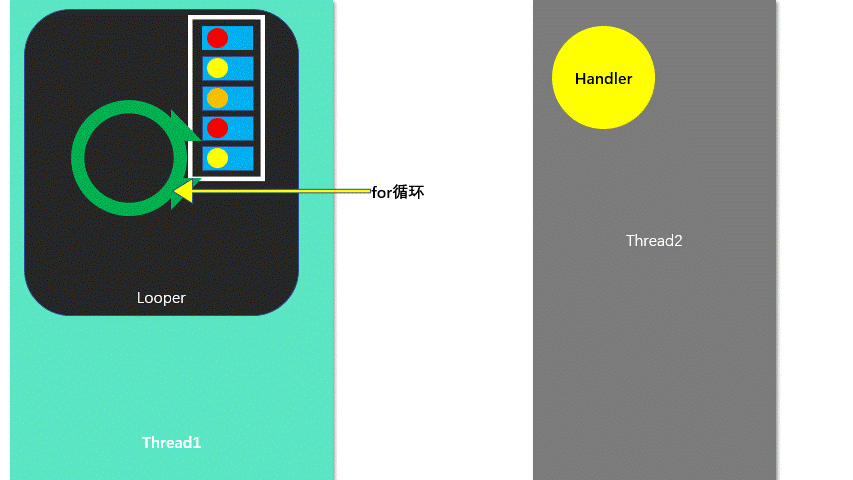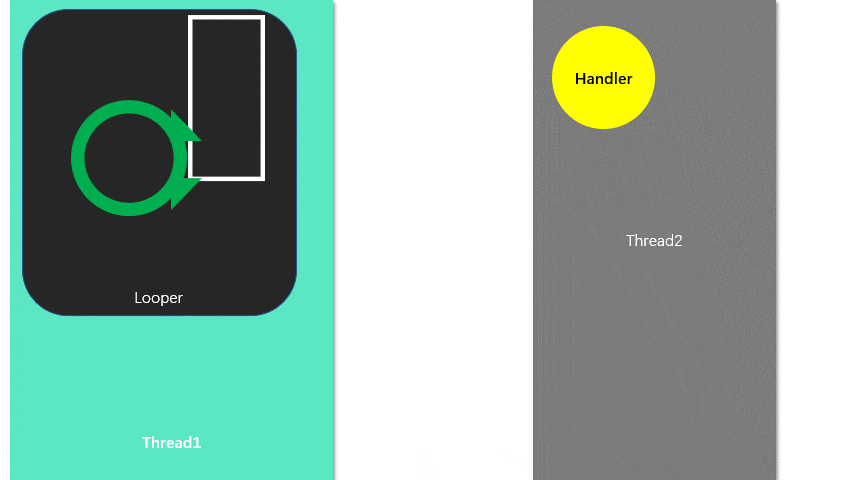文章目录
- 浅析Android的Handler机制
- ThreadLocal
- Handler
- ①专一的Looper与Thread
- 📱当你发送信息的时候你在想什么
- ⚪循环,徘徊着等待她的消息
浅析Android的Handler机制
ThreadLocal
理解Java中的ThreadLocal
position: package java.lang;
Looper初始化的时候,会初始化ThreadLocal
public final class Looper {
/*
* API Implementation Note:
*
* This class contains the code required to set up and manage an event loop
* based on MessageQueue. APIs that affect the state of the queue should be
* defined on MessageQueue or Handler rather than on Looper itself. For example,
* idle handlers and sync barriers are defined on the queue whereas preparing the
* thread, looping, and quitting are defined on the looper.
*/
private static final String TAG = "Looper";
// sThreadLocal.get() will return null unless you've called prepare().
@UnsupportedAppUsage
static final ThreadLocal<Looper> sThreadLocal = new ThreadLocal<Looper>();//👈在这里,ThreadLocal被初始化
@UnsupportedAppUsage
private static Looper sMainLooper; // guarded by Looper.class
private static Observer sObserver;
@UnsupportedAppUsage
final MessageQueue mQueue;
final Thread mThread;
@UnsupportedAppUsage
private Printer mLogging;
private long mTraceTag;
...
}public class Test1 {
private ThreadLocal<String> local1 = new ThreadLocal<>();
private ThreadLocal<String> local2 = new ThreadLocal<>();
public static void main(String[] args) {
Test1 test1 = new Test1();
test1.test();
}
public void test() {
new Thread("Thread1") {
@Override
public void run() {
local1.set("Hello 1#");
System.out.println(local1.get());
local2.set("Hello 2#");
System.out.println(local2.get());
Thread thread = this;
}
}.start();
new Thread("Thread2") {
@Override
public void run() {
local1.set("Hello 1*");
System.out.println(local1.get());
local2.set("Hello 2*");
System.out.println(local2.get());
Thread thread = this;
}
}.start();
}
}我们看到,每个线程会存储属于自己的threadLocals,即ThreadLocal的内部类ThreadLocalMap。
// ThreadLocal#ThreadLocalMap
static class ThreadLocalMap {
/**
* The entries in this hash map extend WeakReference, using
* its main ref field as the key (which is always a
* ThreadLocal object). Note that null keys (i.e. entry.get()
* == null) mean that the key is no longer referenced, so the
* entry can be expunged from table. Such entries are referred to
* as "stale entries" in the code that follows.
*/
static class Entry extends WeakReference<ThreadLocal<?>> {
/** The value associated with this ThreadLocal. */
Object value;
Entry(ThreadLocal<?> k, Object v) {
super(k);
value = v;
}
}
private Entry getEntry(ThreadLocal<?> key) {
int i = key.threadLocalHashCode & (table.length - 1);
Entry e = table[i];
if (e != null && e.get() == key)
return e;
else
return getEntryAfterMiss(key, i, e);
}
...
}public class Test1 {
private ThreadLocal<String> local1 = new ThreadLocal<>();
private ThreadLocal<String> local2 = new ThreadLocal<>();
public static void main(String[] args) {
Test1 test1 = new Test1();
test1.test();
}
public void test() {
new Thread("Thread1") {
@Override
public void run() {
local1.set("Hello 1#");
System.out.println(local1.get());
local2.set("Hello 2#");
System.out.println(local2.get());
Thread thread = this;
}
}.start();
new Thread("Thread2") {
@Override
public void run() {
local1.set("Hello 1*");
System.out.println(local1.get());
local2.set("Hello 2*");
System.out.println(local2.get());
Thread thread = this;
}
}.start();
}
}

当我们使用ThreadLocal的set方法的时候,其内部会检测当前Thread内是否有threadLocals;如果没有则为线程创建;
//ThreadLocal.java
public void set(T value) {
Thread t = Thread.currentThread();
ThreadLocalMap map = getMap(t);
if (map != null)
map.set(this, value);
else
createMap(t, value);
}
/**
* Get the map associated with a ThreadLocal. Overridden in
* InheritableThreadLocal.
*
* @param t the current thread
* @return the map
*/
ThreadLocalMap getMap(Thread t) {
return t.threadLocals;
}
/**
* Create the map associated with a ThreadLocal. Overridden in
* InheritableThreadLocal.
*
* @param t the current thread
* @param firstValue value for the initial entry of the map
*/
void createMap(Thread t, T firstValue) {
t.threadLocals = new ThreadLocalMap(this, firstValue);
}如果有的话,则向当前线程的threadLocals中添加一个Entry
Entry是一个弱引用类型,他就像Map中的Entry一样,可以视为键值对类型,key是ThreadLocal,而value就是我们设置的值。
当我们想要get数据的时候,ThreadLocal会以自己(this)为参数,从他所在的Thread中获得threadLocals(ThreadLocalMap),threadLocals里面有一个Entry型的数组table,使用ThreadLocal自己的threadLocalHashCode进行一番位运算操作,获得一个位置index,这个table[index]就是包含着当前的ThreadLocal的Entry的位置。

下面的图简化了,没有显示出thredLocals,但是threadLocals基本上就是table,因为他里面只有这一个元素
static class ThreadLocalMap {
/**
* The initial capacity -- MUST be a power of two.
*/
private static final int INITIAL_CAPACITY = 16;
/**
* The table, resized as necessary.
* table.length MUST always be a power of two.
*/
private Entry[] table;
/**
* The number of entries in the table.
*/
private int size = 0;
/**
* The next size value at which to resize.
*/
private int threshold; // Default to 0
}
ThreadLocal在不同的线程中,取出来的对应结果是不同的,这也就保证了不同线程的数据互不干扰,而且每个线程中含有ThreadLocal1(或者ThreadLocal2或者ThreadLocalx……)的Entry也具有唯一性。


我们在使用Handler的时候,如果是在非主线程中调用Handler,必须首先调用Looper.prepare(),然后调用Looper.loop()
这个Looper.prepare()就是往其所在线程的threadLocals里面添加Entry(其实是一个内部持有Looper的ThreadLocal弱引用,即我们上面说的ThreadLocalMap内的Entry类),但是要注意:
// Looper.java
private static void prepare(boolean quitAllowed) {
if (sThreadLocal.get() != null) {
throw new RuntimeException("Only one Looper may be created per thread");
}
sThreadLocal.set(new Looper(quitAllowed));//ThreadLocal.set->ThreadLocal#ThreadLocalMap.set->Thread的threadLocals进行添加
}如果我们的线程中没有存入Entry,我们可以通过set方法,创建一个新的Looper,在set方法内部这个Looper会被整合到一个Entry类中,存入Thread的threadLocals;
如果我们的线程中,threadLocals里面的table已经存入一个Entry了,我们就不可以再往里存了,也就是说一个Thread对应一个Looper
所以我们可以认为,在安卓Handler消息机制中,ThreadLocal扮演了一个为不同线程添加Looper,检测和限制线程中Looper数量的角色
Handler
记住,handler的作用是线程间通信切换,而不是单纯只从其他线程切换到主线程
下面这个例子可以证明这个线程间通信的过程:
public class HandlerTestActivity extends AppCompatActivity {
private Button handlerButton;
private TextView textView;
private TestHandler handler;
private Handler handlerInThread1;
private static final String TAG = "HANDLER_TEST";
static class TestHandler extends Handler {
WeakReference<HandlerTestActivity> activity;
public TestHandler(@NonNull Looper looper, HandlerTestActivity act) {
super(looper);
this.activity = new WeakReference<>(act);
}
@Override
public void handleMessage(@NonNull Message msg) {
super.handleMessage(msg);
activity.get().textView.setText("Hello Boy!");
}
}
@Override
protected void onCreate(Bundle savedInstanceState) {
super.onCreate(savedInstanceState);
setContentView(R.layout.activity_handler_test);
handler = new TestHandler(Looper.getMainLooper(), this);
handlerButton = findViewById(R.id.handler_btn_test);
textView = findViewById(R.id.handler_txt_input);
new Thread(() -> {
Looper.prepare();
handlerInThread1 = new Handler(Looper.myLooper()) {
@Override
public void handleMessage(@NonNull Message msg) {
super.handleMessage(msg);
Log.d(TAG, "handleMessage: enter handler1!");
handler.handleMessage(msg);
}
};
Looper.loop();
}).start();
handlerButton.setOnClickListener(v -> {
new Thread(() -> {
Message obtain = Message.obtain();
obtain.what = 1;
Bundle bundle = new Bundle();
bundle.putString("info", "Hello Boy!");
obtain.setData(bundle);
while (handlerInThread1 == null);
handlerInThread1.sendMessage(obtain);
// handler.sendMessage(obtain);
}).start();
});
}
}Android学习笔记4:关于handler以及它已过时的构造函数handler()

比如线程1想向线程2发送消息,必须使用在线程2内部创建的handler。
那么handler是如何把消息发送出去并且切换到不同的线程的呢?
①专一的Looper与Thread
private static void prepare(boolean quitAllowed) {
if (sThreadLocal.get() != null) {
throw new RuntimeException("Only one Looper may be created per thread");
}
sThreadLocal.set(new Looper(quitAllowed));
}创建Handler之前,首先要调用Looper.prepare(),目的是为该线程创建唯一的一个Looper,该Looper存在ThreadLocal中,具体分析见上一节ThreadLocal。
一个Thread的♥中,只有一个Looper的位置。
📱当你发送信息的时候你在想什么
当我们调用handlerThread1.sendMessage的时候都发生了什么
我们来好好看看handler的调用过程
//handlerInThread1 接受消息的Handler
new Thread(() -> {
Looper.prepare();
handlerInThread1 = new Handler(Looper.myLooper()) {
@Override
public void handleMessage(@NonNull Message msg) {
super.handleMessage(msg);
Log.d(TAG, "handleMessage: enter handler1!");
handler.handleMessage(msg);
}
};
Looper.loop();
}).start();
new Thread(() -> {
Message obtain = Message.obtain();
obtain.what = 1;
Bundle bundle = new Bundle();
bundle.putString("info", "Hello Boy!");
obtain.setData(bundle);
while (handlerInThread1 == null);
handlerInThread1.sendMessage(obtain);
// handler.sendMessage(obtain);
}).start();👉首先,我们通过Message.obtain获得了一个Message对象
👉往Message对象中添加了数据后,调用Handler的sendMessage方法
//Handler.java
public final boolean sendMessage(@NonNull Message msg) {
return sendMessageDelayed(msg, 0);
}
public final boolean sendMessageDelayed(@NonNull Message msg, long delayMillis) {
if (delayMillis < 0) {
delayMillis = 0;
}
return sendMessageAtTime(msg, SystemClock.uptimeMillis() + delayMillis);
}
public boolean sendMessageAtTime(@NonNull Message msg, long uptimeMillis) {
MessageQueue queue = mQueue;
if (queue == null) {
RuntimeException e = new RuntimeException(
this + " sendMessageAtTime() called with no mQueue");
Log.w("Looper", e.getMessage(), e);
return false;
}
return enqueueMessage(queue, msg, uptimeMillis);
}
private boolean enqueueMessage(@NonNull MessageQueue queue, @NonNull Message msg,
long uptimeMillis) {
msg.target = this;//把目前的Handler存入Message
msg.workSourceUid = ThreadLocalWorkSource.getUid();
if (mAsynchronous) {
msg.setAsynchronous(true);
}
return queue.enqueueMessage(msg, uptimeMillis);
}👉最后调用queue.enqueMessage方法,queue是Looper内部的MessageQueue,enqueueMessage()就是往消息队列MessageQueue中插入了一条信息。
每个线程内含有一个唯一的Looper,每个线程都有属于自己的一些Handler,Handler内部持有自己所在线程的Looper,当我们调用Handler.sendMessage方法传送Message的时候,就会把Handler调用Looper内部的MessageQueue的enqueueMessage方法,把Message存入MessageQueue;
//Handler.java
/**
* Use the provided {@link Looper} instead of the default one.
*
* @param looper The looper, must not be null.
*/
public Handler(@NonNull Looper looper) {
this(looper, null, false);
}
@UnsupportedAppUsage
public Handler(@NonNull Looper looper, @Nullable Callback callback, boolean async) {
mLooper = looper;
mQueue = looper.mQueue;
mCallback = callback;
mAsynchronous = async;
}
private boolean enqueueMessage(@NonNull MessageQueue queue, @NonNull Message msg,
long uptimeMillis) {
msg.target = this;//把目前的Handler存入Message
msg.workSourceUid = ThreadLocalWorkSource.getUid();
if (mAsynchronous) {
msg.setAsynchronous(true);
}
return queue.enqueueMessage(msg, uptimeMillis);
}总结下来就是:
Handler->MessageQueue#enqueueMessage 发送信息,同时记录下当前发送信息的Handler,将引用存入Message当中
⚪循环,徘徊着等待她的消息
Looper->MessageQueue#next,获得信息
我们知道,在非主线程使用Looper的时候,不仅需要调用Looper.prepare,还要调用Loop.loop开启这个Looper。
开启looper后,该线程会启动一个for循环,调用MessageQueue的next方法
//Looper.java
public static void loop() {
final Looper me = myLooper();
if (me == null) {
throw new RuntimeException("No Looper; Looper.prepare() wasn't called on this thread.");
}
final MessageQueue queue = me.mQueue;
...
for (;;) {
Message msg = queue.next(); // might block 如果queue内部为空的话,会一直等待,也就是block
if (msg == null) {
// No message indicates that the message queue is quitting.
return;
}
...
long origWorkSource = ThreadLocalWorkSource.setUid(msg.workSourceUid);
try {
msg.target.dispatchMessage(msg);//在这里,handler发送信息
if (observer != null) {
observer.messageDispatched(token, msg);
}
dispatchEnd = needEndTime ? SystemClock.uptimeMillis() : 0;
} catch (Exception exception) {
...
} finally {
...
}
...
msg.recycleUnchecked();
}
}我们看看next方法
//MessageQueue
@UnsupportedAppUsage
Message next() {
// Return here if the message loop has already quit and been disposed.
// This can happen if the application tries to restart a looper after quit
// which is not supported.
...
for (;;) {
...
nativePollOnce(ptr, nextPollTimeoutMillis);
synchronized (this) {
// Try to retrieve the next message. Return if found.
...
}
}
}MessageQueue的next方法也是一个for循环,从自身的消息链表中查找不为空的消息,并返回给Looper,否则就一直循环,这时候Looper内部就一直停留在Message msg = queue.next方法处,也就说,Looper被block了。
在Looper中,一旦获得了msg,便会立即发送消息
msg.target.dispatchMessage(msg);//在这里,handler发送信息
我们在上面分析过,msg.target是一个Handler类型,
//Handler.java
private boolean enqueueMessage(@NonNull MessageQueue queue, @NonNull Message msg,
long uptimeMillis) {
msg.target = this;//👈
msg.workSourceUid = ThreadLocalWorkSource.getUid();
if (mAsynchronous) {
msg.setAsynchronous(true);
}
return queue.enqueueMessage(msg, uptimeMillis);
}//Handler
/**
* Handle system messages here.
*/
public void dispatchMessage(@NonNull Message msg) {
if (msg.callback != null) {//如果Message设置了Callback,优先调用
handleCallback(msg);
} else {
if (mCallback != null) {
if (mCallback.handleMessage(msg)) {//Handler本身设置了Callback,其次调用
return;
}
}
handleMessage(msg);//👈看这里,如果上面两个Callback都没设置,最终调用Handler的handleMessage方法
}
}Handler以及Message都可以设置Callback接口,用法类似于View的setOnClickListner,这里就不过多解释了。
Looper\MessageQueue\Handler之间的引用关系大致如下图:

而这整个流程的大致示意如以下动图:

整个Looper轮转的过程如下图所示:






















